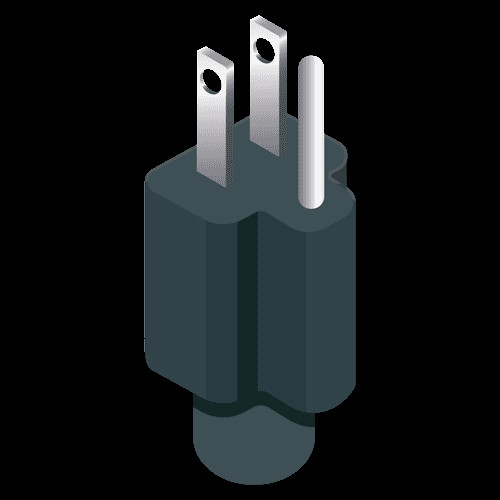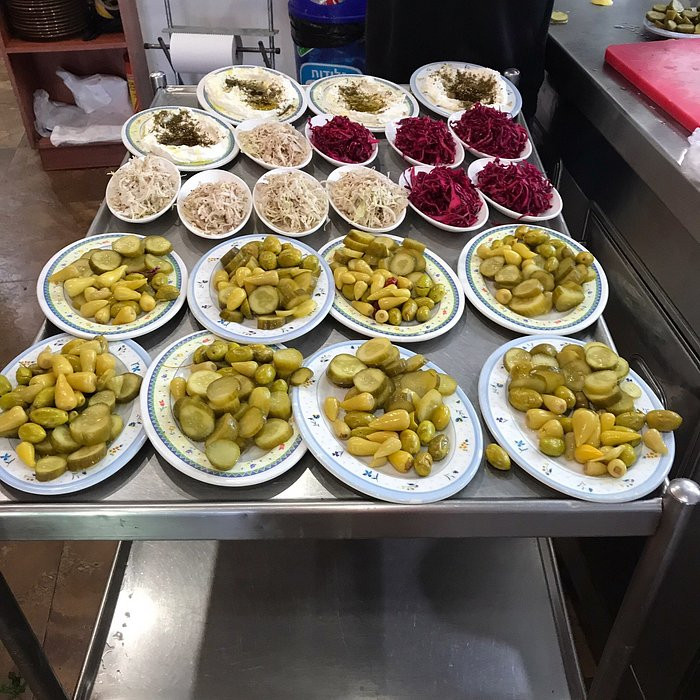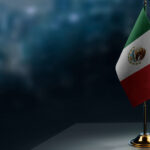Are Mexican Plugs The Same As American plugs? At gaymexico.net, we know that understanding the electrical compatibility between the US and Mexico is essential for LGBTQ+ travelers to stay connected and powered up on your adventures. This guide clarifies plug types and voltage needs for a hassle-free trip, ensures seamless travel experiences within Mexico, and allows you to enjoy your journey without worrying about power compatibility issues.
1. Understanding Electrical Standards: Mexico Vs. The United States
Do Mexican plugs match the ones in the USA? The answer is mostly yes, but with a few crucial details. Both Mexico and the United States primarily use Type A and Type B plugs. However, knowing the voltage and frequency differences can save you from frying your favorite devices.
1.1 Plug Types: A Closer Look
- Type A: These plugs have two flat parallel pins.
- Type B: These have two flat parallel pins and a round grounding pin.
 Type A power plug found in both Mexico and the United States, featuring two flat parallel pins.
Type A power plug found in both Mexico and the United States, featuring two flat parallel pins.
1.2 Voltage and Frequency: What You Need to Know
| Country | Voltage | Frequency |
|---|---|---|
| United States | 120V | 60Hz |
| Mexico | 127V | 60Hz |
While both countries operate at 60Hz, Mexico’s standard voltage is slightly higher at 127V compared to the US’s 120V.
2. Will Your American Plugs Work In Mexico?
Yes, your American plugs will generally work in Mexico. Most modern devices are designed to handle slight voltage variations. However, it’s wise to check your device’s power adapter. If it says “Input: 100-240V, 50/60Hz,” you’re in the clear. If not, a voltage converter might be necessary for older or sensitive electronics.
2.1 Devices That Usually Don’t Need a Converter
- Smartphones
- Laptops
- Tablets
- Digital Cameras
2.2 Devices That Might Need a Converter
- Hair dryers
- Curling irons
- Some older electronics
3. When Do You Need A Plug Adapter In Mexico?
You might need a plug adapter in Mexico if your device has a Type B plug and you only find Type A sockets available. Always pack a 3-to-2 prong adapter to ensure your plugs fit into any socket.
 Type B power plug, commonly used in the United States and Mexico, featuring two flat parallel pins and a round grounding pin.
Type B power plug, commonly used in the United States and Mexico, featuring two flat parallel pins and a round grounding pin.
3.1 Why Carry a 3-To-2 Prong Adapter?
Many older buildings or budget accommodations in Mexico may only have Type A sockets. Carrying an adapter ensures you can plug in your devices anywhere.
3.2 Where To Buy Plug Adapters
- Amazon
- Major electronics retailers (e.g., Best Buy)
- Travel stores (e.g., AAA)
4. Voltage Converters: When Are They Necessary?
Voltage converters are essential when your device isn’t compatible with Mexico’s 127V. These devices step down the voltage to prevent damage to your electronics.
4.1 How To Identify If You Need A Converter
Check the label on your device. If it only lists 120V, you’ll need a converter. If it lists a range like 100-240V, you’re good to go.
4.2 Types Of Voltage Converters
- Step-Down Converters: These reduce the voltage from 127V to 120V.
- Universal Converters: These can handle a range of voltages, making them ideal for international travel.
5. Recommended Travel Adapters For Mexico
Choosing the right travel adapter can make your trip smoother. Here are a few highly-rated options available on Amazon:
| Adapter | Features | Price |
|---|---|---|
| Universal Travel Power Adapter – EPICKA | All-in-one design, USB ports, surge protection | $22.99 |
| Ceptics Safest Travel Adapter Kit | Includes multiple adapters, grounded for safety | $34.99 |
| Worldwide All in One Universal Travel Adaptor | Compact, fits multiple socket types | $16.99 |
| FOVAL Travel Adapter and Voltage Converter | Combines adapter and converter functions, suitable for high-power devices | $35.98 |
6. Staying Safe: Electrical Safety Tips For Mexico
- Check the Voltage: Always verify your device’s voltage compatibility before plugging it in.
- Use Surge Protectors: Power surges can happen, so protect your electronics with a surge protector.
- Avoid Overloading Sockets: Don’t plug too many devices into one outlet.
- Inspect Cords: Look for frayed or damaged cords, which can be a fire hazard.
6.1 What To Do If You Experience A Power Surge
Unplug your devices immediately and check for any damage. Contact the hotel or property management if you notice any electrical issues.
6.2 Local Emergency Numbers
- Emergency: 911
7. Mexico For LGBTQ+ Travelers: Safety And Inclusivity
Mexico is increasingly welcoming to LGBTQ+ travelers. Cities like Puerto Vallarta, Mexico City, and Cancun are known for their vibrant LGBTQ+ scenes and inclusive environments.
7.1 LGBTQ+ Friendly Destinations In Mexico
- Puerto Vallarta: Renowned for its gay beaches, clubs, and resorts.
- Mexico City: Offers a rich cultural experience with numerous LGBTQ+ venues.
- Cancun: Known for its stunning beaches and inclusive resorts.
 Gay beach in Puerto Vallarta, Mexico, showcasing a vibrant and inclusive atmosphere.
Gay beach in Puerto Vallarta, Mexico, showcasing a vibrant and inclusive atmosphere.
7.2 Resources For LGBTQ+ Travelers
- gaymexico.net: Your go-to source for LGBTQ+ travel information in Mexico.
- Local LGBTQ+ Organizations: Organizations like Cuenta Conmigo offer support and resources.
- Human Rights Watch: Provides reports on LGBTQ+ rights in Mexico.
8. Cultural Considerations For LGBTQ+ Travelers In Mexico
While Mexico is becoming more accepting, it’s essential to be aware of local customs. Public displays of affection might be more accepted in tourist areas than in smaller towns.
8.1 Understanding Local Attitudes
Research local attitudes towards LGBTQ+ individuals in the areas you plan to visit. This can help you navigate social situations more comfortably.
8.2 Respecting Local Customs
Be mindful of local customs and traditions. While major cities are generally accepting, more conservative areas may require a more discreet approach.
9. Planning Your Trip: Essential Checklist
- Passport: Ensure your passport is valid for at least six months beyond your travel dates.
- Travel Insurance: Protect yourself against unexpected medical expenses or travel disruptions.
- Medications: Bring any necessary medications and a copy of your prescription.
- Plug Adapters: Pack the appropriate plug adapters for your devices.
- Voltage Converter (If Needed): Ensure your sensitive electronics are protected.
9.1 Documents To Carry
- Passport
- Visa (if required)
- Flight/hotel confirmations
- Travel insurance details
9.2 Packing Essentials
- Sunscreen
- Insect repellent
- Comfortable shoes
- Appropriate clothing for the climate
10. Exploring Mexico: Beyond The Plugs
Mexico offers a diverse range of experiences for LGBTQ+ travelers, from stunning beaches to vibrant cultural hubs.
10.1 Popular Destinations
- Mexico City: Explore historical sites, museums, and LGBTQ+ nightlife.
- Puerto Vallarta: Relax on gay beaches and enjoy the town’s welcoming atmosphere.
- Cancun: Indulge in luxurious resorts and explore the Riviera Maya.
- Guadalajara: Experience traditional Mexican culture with a modern twist.
- Oaxaca: Discover indigenous traditions, colorful markets, and delicious cuisine.
10.2 Activities And Attractions
- Historical Sites: Visit ancient ruins like Teotihuacan and Chichen Itza.
- Beaches: Relax on the beaches of Cancun, Playa del Carmen, and Tulum.
- Nightlife: Experience the vibrant LGBTQ+ nightlife in Mexico City and Puerto Vallarta.
- Cultural Events: Attend festivals like Día de Muertos and Guelaguetza.
11. Staying Connected: Internet And Mobile Services
Staying connected is crucial, especially when traveling internationally. Mexico has decent internet and mobile services, but it’s essential to know your options.
11.1 Mobile Carriers In Mexico
- Telcel: The largest carrier with the best coverage.
- Movistar: Offers competitive rates and good coverage.
- AT&T Mexico: A subsidiary of the US carrier, providing seamless roaming options.
11.2 Buying A Local SIM Card
Purchasing a local SIM card can be more cost-effective than using international roaming. You can buy SIM cards at airports, convenience stores, and mobile carrier stores.
11.3 Wi-Fi Availability
Wi-Fi is widely available in hotels, restaurants, and cafes in major cities. However, connectivity might be limited in rural areas.
12. Money Matters: Currency And Payment Methods
Mexico uses the Mexican Peso (MXN). While credit cards are widely accepted in tourist areas, it’s wise to carry some cash for smaller establishments and markets.
12.1 Currency Exchange
You can exchange currency at airports, banks, and exchange houses. Banks usually offer the best exchange rates.
12.2 Using Credit Cards
Major credit cards like Visa and Mastercard are widely accepted. However, smaller establishments might prefer cash.
12.3 Tipping Etiquette
Tipping is customary in Mexico. A 10-15% tip is standard in restaurants, and you should also tip hotel staff and tour guides.
13. Health And Safety: Staying Well In Mexico
Your health and safety should be a top priority when traveling. Here are some tips to ensure a safe and healthy trip.
13.1 Vaccinations
Check with your doctor about recommended vaccinations for Mexico. Common vaccinations include hepatitis A and typhoid.
13.2 Food And Water Safety
Drink bottled water and avoid ice in drinks. Eat at reputable restaurants and avoid street food that looks questionable.
13.3 Travel Insurance
Ensure you have comprehensive travel insurance that covers medical expenses, trip cancellations, and loss of belongings.
14. Transportation: Getting Around Mexico
Mexico offers various transportation options, from taxis and buses to rental cars and ride-sharing services.
14.1 Taxis And Ride-Sharing
Taxis are widely available in cities, but it’s essential to negotiate the fare beforehand. Ride-sharing services like Uber and Didi are also available in major cities.
14.2 Buses
Buses are a cost-effective way to travel between cities. Companies like ADO and Primera Plus offer comfortable and reliable services.
14.3 Rental Cars
Renting a car gives you the freedom to explore at your own pace. However, be aware of local driving conditions and traffic.
15. Useful Spanish Phrases For Travelers
Knowing a few basic Spanish phrases can enhance your travel experience and help you connect with locals.
15.1 Basic Greetings
- Hola (Hello)
- Buenos días (Good morning)
- Buenas tardes (Good afternoon)
- Buenas noches (Good evening/night)
- Cómo está? (How are you?)
- Bien, gracias (Fine, thank you)
15.2 Essential Phrases
- Por favor (Please)
- Gracias (Thank you)
- De nada (You’re welcome)
- Perdón (Excuse me/Sorry)
- ¿Cuánto cuesta? (How much does it cost?)
- ¿Dónde está…? (Where is…?)
- No entiendo (I don’t understand)
- Habla inglés? (Do you speak English?)
15.3 Phrases For LGBTQ+ Travelers
- Soy gay/lesbiana/bisexual (I am gay/lesbian/bisexual)
- Dónde hay bares gay? (Where are the gay bars?)
- Es un lugar seguro para LGBTQ+? (Is this a safe place for LGBTQ+?)
16. Events And Festivals: Celebrating Pride In Mexico
Mexico hosts several LGBTQ+ pride events throughout the year. These festivals are a great way to celebrate diversity and connect with the local community.
16.1 Pride Events In Mexico
- Mexico City Pride: One of the largest pride parades in Latin America, held in June.
- Puerto Vallarta Pride: A week-long celebration with parades, parties, and cultural events, held in May.
- Guadalajara Pride: A vibrant celebration with a parade and various LGBTQ+ events, held in June.
16.2 Other LGBTQ+ Events
- Arena Festival (Puerto Vallarta): A popular electronic music festival for gay men, held in January/February.
- Vallarta Heat (Puerto Vallarta): A series of parties and events during the summer months.
17. gaymexico.net: Your Ultimate Guide To LGBTQ+ Travel In Mexico
For comprehensive and up-to-date information on LGBTQ+ travel in Mexico, visit gaymexico.net. We provide guides, tips, and resources to help you plan a safe and enjoyable trip.
17.1 What We Offer
- Detailed travel guides for LGBTQ+ destinations in Mexico
- Listings of gay bars, clubs, hotels, and events
- News and information on LGBTQ+ rights and issues in Mexico
- A community forum for connecting with other LGBTQ+ travelers
17.2 Connect With Us
- Address: 3255 Wilshire Blvd, Los Angeles, CA 90010, United States
- Phone: +1 (213) 380-2177
- Website: gaymexico.net
18. Conclusion: Power Up Your Mexican Adventure
Understanding the electrical standards in Mexico ensures a smooth and enjoyable trip. While Mexican plugs are generally the same as American plugs, it’s essential to be prepared with the right adapters and converters. With gaymexico.net, you can plan your LGBTQ+ travel with confidence, knowing you have access to the best resources and information.
19. Frequently Asked Questions (FAQ)
19.1 Do I need a power plug adapter in Mexico?
Yes, you may need a power plug adapter in Mexico if your device has a Type B plug, and you only find Type A sockets available. It is best to pack a 3-to-2 prong adapter to ensure your plugs fit into any socket.
19.2 Do I need a voltage converter in Mexico?
You might need a voltage converter in Mexico if your device isn’t compatible with Mexico’s 127V. Check the label on your device; if it only lists 120V, you’ll need a converter. If it lists a range like 100-240V, you’re good to go.
19.3 What plug types are used in Mexico?
Mexico uses Type A and Type B plugs, similar to the United States.
19.4 Is the voltage the same in Mexico as in the US?
No, the voltage in Mexico is 127V, while in the US, it is 120V. Most modern devices can handle this slight difference, but check your device’s label to be sure.
19.5 Are there LGBTQ+ friendly destinations in Mexico?
Yes, cities like Puerto Vallarta, Mexico City, and Cancun are known for their vibrant LGBTQ+ scenes and inclusive environments.
19.6 How can I stay connected in Mexico?
You can buy a local SIM card, use international roaming, or rely on Wi-Fi, which is widely available in hotels, restaurants, and cafes in major cities.
19.7 What are some essential items to pack for a trip to Mexico?
Essential items include a passport, travel insurance, necessary medications, plug adapters, and a voltage converter (if needed).
19.8 How much should I tip in Mexico?
A 10-15% tip is standard in restaurants, and you should also tip hotel staff and tour guides.
19.9 What are some useful Spanish phrases for travelers?
Useful phrases include “Hola” (Hello), “Gracias” (Thank you), “¿Cuánto cuesta?” (How much does it cost?), and “¿Dónde está…?” (Where is…?).
19.10 Where can I find more information about LGBTQ+ travel in Mexico?
Visit gaymexico.net for detailed travel guides, listings of LGBTQ+ venues, and news on LGBTQ+ rights and issues in Mexico.
Plan your trip to Mexico with confidence, knowing you’re prepared for both the electrical outlets and the vibrant LGBTQ+ scene. Visit gaymexico.net to discover the best destinations, events, and resources for LGBTQ+ travelers in Mexico. Get ready for an unforgettable adventure!
